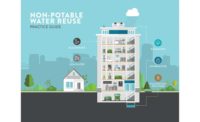On Jan. 19, nearly a year after the sudden death of William J. Worthen, the champion for an e-book on non-potable water reuse in buildings, the team shepherding the project to completion is releasing the free-to-all e-guide.
The "Non-Potable Water Reuse Practice Guide" is a "living breathing document" and will be updated as needed, says Kyle Pickett, managing principal of sustainability consultant Urban Fabrick Inc. and co-founder and executive director of the William J. Worthen Foundation. The group, formerly known as the Urban Fabrick Collaborative, was recently renamed in honor of its co-founder Worthen, who died last Jan. 28.
The release of the guide was delayed many months by Worthen's death. "Aside from making us sad, Bill's death galvanized us to get the guide done in a fashion he would have found suitable," says Brett Rosenbereg, Urban Fabrick's project manager and the person who replaced Worthen as principal investigator for the guide.
One of the biggest impediments to water reuse is to get past the "yuck factor," adds Rosenberg. People think it will be "overly stinky, unsafe and make appliances and fixtures a yucky color," he says. The guide is intended to assuage those fears by making it clear that the systems work if installed and maintained properly, he adds.
The 122-page guide, available in draft form on collaborativedesign.org, addresses project design, scope definition, system specification, permitting and operation of onsite non-potable water reuse technologies. These include rainwater, stormwater, and gray- and blackwater systems for residential and nonresidential uses. The e-book, targeted toward architects and engineers, also offers onsite treatment strategies and conservation measures.
Some of the 10 chapter titles are, "Is non-potable water reuse appropriate for your project?"; How does non-potable water reuse impact the design process?"; "Build and operate a system--what you need to know"; and "Can I get this thing permitted?"
Though specifically directed at practicing architects and engineers, the guide also is meant for municipal and regulatory authorities that may not be familiar with onsite non-potable water reuse. One goal of the e-book is to help design teams shorten planning and entitlement reviews for projects with non-potable water reuse systems.
The most challenging task for the guide's 26-person working group was to determine "what to include, while keeping it relevant yet not overwhelming readers with too much detail," says Rosenberg.
The Charles Pankow Foundation provided $60,000 toward the guide. Other funders are Google, the AIA California Council, Magnusson Klemencic Associates, WE&RF, Crescent Heights, Urban Fabrick Inc., and Santa Monica, Calif.
Pickett quotes Worthen, in a recent press release: "The challenge for most architects is to understand how to better engage in a water discussion much earlier in the design process. If the first time you seriously discuss water with your client and plumbing engineer is at the time of bathroom and kitchen fixture selection, or when running the calculations to confirm how many LEED credits you get, you are very likely missing some interesting opportunities to collaborate and engage with your client and project team on the subject of water."





Post a comment to this article
Report Abusive Comment